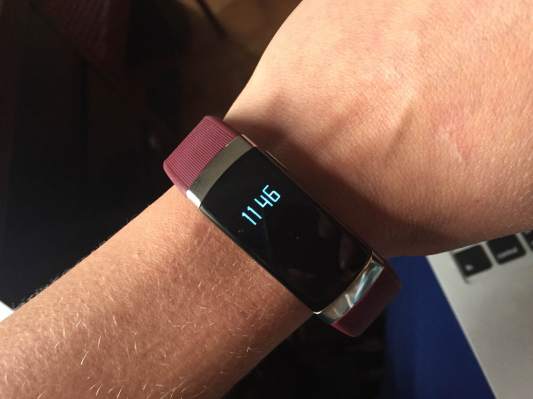Most fitness trackers are all about numbers. How many steps did you take? How many flights of stairs did you climb? How many projected calories did you burn?
But there is one number (an important one, if you’re a health nut) that is left out of almost every fitness tracker on the market: BMI.
The InBody Band, made by a South Korean company that makes professional-scale body composition tools, is one of the first trackers for the consumer market that will tell you about the makeup of your body.
But when you strap on a fitness tracker, is that what you want?
Design
While other companies like Apple and Fitbit are working to make products that don’t look like fitness gear, InBody doesn’t seem to have made style a priority.
The InBodyBand looks like every first-gen fitness tracker, bearing a striking resemblance to the FitBit Alta. It comes with a polymer band, and the display is long and skinny, though rather thick against the wrist.
That is presumably to make room for the electrodes (which measure body composition) and for the battery, which is supposed to last one week on a single charge. I found that it lasts closer to five days then a full week. The Band charges via microUSB.
The LCD display is bright and easy to read, though bright sunlight may make things more difficult.
Users can simply press the button to the side of the display to run through their daily metrics, and of course, check the time. It’s worth noting that the display is not an always-on display, so you still need to press the button to check the time. In other words, this isn’t a great watch replacement.
The InBodyBand comes in five different colors — black, grey, maroon, pink, and orange — each with silver flourishes near the display.
Performance
As I mentioned, the InBodyBand does everything you’d expect out of a fitness tracker — measuring steps, calories burned, distance traveled, and sleep — and does it well. However, that type of functionality is rather boring in 2016.
But the InBody Band also measures body composition and heart rate using special electrodes on the inside of the device. Users can test this by holding the band against the skin, which takes under a minute. The heart rate test takes even less time (under ten seconds).
The electrodes send a small current through the body and measure voltage, giving information back about the composition of the body. The app then makes suggestions about how to be more healthy, whether it’s losing fat or building more muscle.
Though this method isn’t quite as accurate as professional-grade machines, which can cost in the thousands of dollars, it is not meant for an exact read-out as much as a long-term look at changes in body composition.
For that, the InBody Band does exactly what it’s supposed to do. The tests are quick and painless, and you can see slight changes over time in BMI.
That said, these tests don’t seem like a daily necessity, especially considering that there are smart scales on the market that can perform the same tests.
[gallery ids="1315630,1315629,1315628,1315627"]
The App
InBody displays this information through the InBody app.
The app also lets you specify which activities you were doing during various activity spikes in your records, much like FitBit’s latest devices. However, the FitBit is able to determine your activity based on motion, where the InBody Band requires manual input of this information.
Oddly, the app doesn’t record heart rate information. Instead, your read-out shows up on the display for a few seconds and disappears forever. If this is a stat you’re looking to track over time with detailed records, you’re looking at far more work than simply pressing a button. Finally, the app offers text notification alerts that vibrate on the Band itself.
Bottom Line
Both the hardware and the software perform up to par. While I wish the screen was brighter in direct sunlight, the battery life on this guy was more than acceptable and it seems accurate (when weighed against info from my other fitness trackers). I also found that the ability to track my body fat, muscle, etc. was fascinating if generally unnecessary.
There’s no real problem with the InBody Band, per se, but I’m not sure I’m the type of person who needs BMI tracking, especially for this price.
For the true fitness aficionado, the InBody Band might represent a worthwhile option. It offers a deeper look at the body and how it responds to various activities, foods, etc. However, it’s hard to line up the InBody Band with other fitness trackers like a FitBit for the more casual user.
The design is rooted in fitness and not style, and the extra information around BMI may not be useful to casual users. Plus, the InBody Band costs $180, which places it in an awkward space between a true smart watch (with built-in fitness tracking abilities) and far cheaper fitness trackers that cover all the basics like steps, calories, etc.
